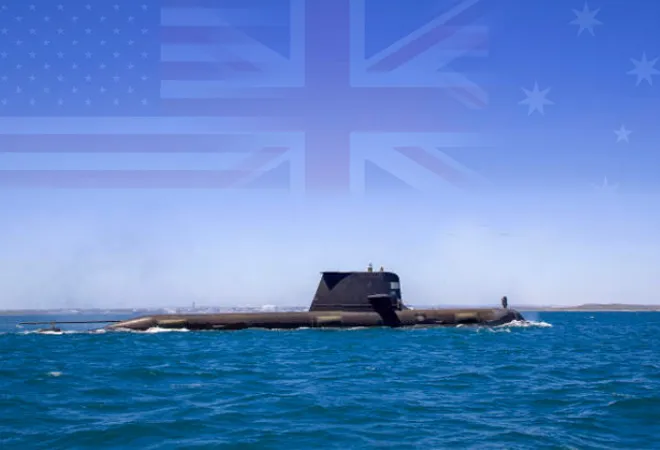-
CENTRES
Progammes & Centres
Location
The plan to provide Australia with nuclear attack submarines signals a sharpening of great power rivalry in the Indo-Pacific

After months of suspense, the United States (US), United Kingdom (UK), and Australia have a roadmap to provide Australia with nuclear-powered attack submarines (SSNs). The much-awaited announcement came earlier this week at a naval base in San Diego, California, where US President Joe Biden, Australian Prime Minister Anthony Albanese, and UK Prime Minister Rishi Sunak outlined the AUKUS submarine programme's parameters. Under the terms of the agreement, the US will sell three used Virginia-class nuclear-powered submarines to Australia in the early 2030s, with an option for Australia to purchase two more if needed. This is accompanied by a joint US-UK submarine construction initiative, as well as efforts to train Australian sailors to operate SSNs.
The partners have agreed on a four-step plan. The US will increase SSN port visits to Australia in the first phase, beginning in 2023, with Australian military and civilian personnel co-crewing allied boats, and gaining experience in operating nuclear-powered attack submarines. Then, starting in 2027, American and British submarines will forward deploy to Australia on a rotational basis, with the latter increasing investments in port facilities for SSN maintenance.
The third phase will involve the transfer of Virginia-class SSNs from the US to Australia. Under the agreement, Canberra will invest in the US shipbuilding industry. In the third and final phase, Australia and the UK will collaborate to build the SSN AUKUS, a “new state-of-the-art platform designed to leverage the best of submarine technology from all three nations.” According to a fact sheet released by the US White House, both Australia and the UK will build and deploy the submarine, which will be based on the latter’s next-generation SSN design while incorporating cutting-edge US submarine technologies.
Prior to the announcement, there were three possible “optimal paths” for Australia. Canberra could choose between US-made or UK-built boats or have opted to build a new generation submarine. All three options have been incorporated into the final plan, ensuring that the Royal Australian Navy (RAN) benefits from both US and UK-built submarines while undertaking the construction of a next-generation SSN with assistance from the UK. In the years leading up to the commissioning of its own SSNs, Australia will receive assistance from the United States, which will forward deploy its submarines to what the three allies are referring to as “Submarine Rotational Force West.” This could also include one British Astute class submarine.
The fact that US policymakers are willing to invest in a partner’s capabilities despite the obvious costs for US force readiness, says something about Washington’s commitment to integrated deterrence in the Indo-Pacific region.
Notably, reactions to the plan have been mixed. Australian experts are largely enthused, seeing the programme as a necessary step to deter China. Many say a trilateral design and a joint UK-Australian effort to build the new submarine is a smart move as it helps “de-risk the Australian build.” For a country with no experience in building a first-of-its-kind nuclear vessel, the challenges for Australia indeed appear significant. The AUKUS roadmap, proponents point out, is intended to reduce the pain for Canberra as it expands its manufacturing facilities, ensuring that the larger share of production in the early years lies with the UK. Even so, the majority of Australian boats will still be manufactured in Australia, benefiting the country’s shipbuilding industry.
But critics claim that the strategy is both costly and potentially escalatory. Australia's total cost over the next three decades could exceed US$368 billion, an exorbitant figure; the same effects could have been achieved in far more cost-effective ways. Sceptics argue that the risks to the United States and the United Kingdom should not be overlooked. The United Kingdom's "Indo-Pacific tilt" may overstretch the country's military and divert resources away from the Russian threat. Washington may end up sharing some of the country's most closely guarded technological secrets without much to show since Australia neither has the capacity nor the fiscal bandwidth to achieve the economies of scale needed to produce nuclear submarines. Some say that the confrontational nature of AUKUS is more concerning. The pact, they posit, recklessly throws Australia onto the frontlines of the US-China rivalry, with ominous implications for Canberra. In their telling, AUKUS partners disregard the balance of inclusivity that has so painstakingly been achieved in the Indo-Pacific.
The plan to give Australia nuclear submarines also signals a clear intent on the part of AUKUS to balance China.
From an Indian perspective, two facts stand out. First, Australia could receive its first four US Virginia-class submarines as early as 2027, implying that China's deterrence in the Indo-Pacific will likely increase in the coming years; it also implies that the regional littorals may become more crowded and contested than ever before. More noteworthy for New Delhi is Washington's willingness to share its “crown jewel” nuclear propulsion technology with a strategic partner at a seeming cost to US plans for force modernisation. America’s offer of SSNs to Australia is a leap of faith, as the US Navy is struggling to make up for a shortage of nuclear attack submarines. The fact that US policymakers are willing to invest in a partner’s capabilities despite the obvious costs for US force readiness, says something about Washington’s commitment to integrated deterrence in the Indo-Pacific region. If the new US approach of assisting partners at a considerable cost to itself is intended to extend beyond the Anglophone alliance, there is hope that India could receive the assistance that it has always desired but never received.
The plan to give Australia nuclear submarines also signals a clear intent on the part of AUKUS to balance China. Australia, like India, faces an adverse strategic environment in its near region. Canberra faces the threat of an assertive and aggressive China determined to establish regional hegemony. Australian policymakers are rightly wary of a future in which China is the dominant actor in the Indo-Pacific, with the US retrenching from the region. As they see it, nuclear submarines could make their country capable of defending Australian interests. Australian attack submarines could in the future even patrol and secure key chokepoints in the Western Pacific and the eastern Indian Ocean, which, for Indian observers, is the key upshot. Whatever their apprehensions about allied navies superseding India’s principal security role in its maritime backyard, the risks for Australia and AUKUS seem well-worth taking.
The views expressed above belong to the author(s). ORF research and analyses now available on Telegram! Click here to access our curated content — blogs, longforms and interviews.

A former naval officer Abhijit Singh Visiting Fellow at ORF. A maritime professional with specialist and command experience in front-line Indian naval ships he has been ...
Read More +